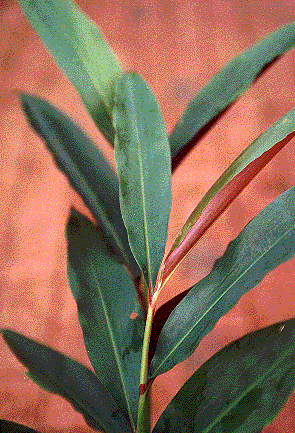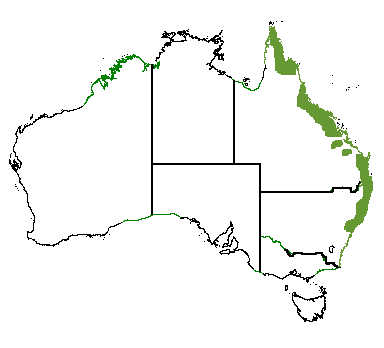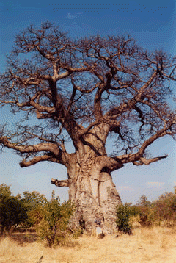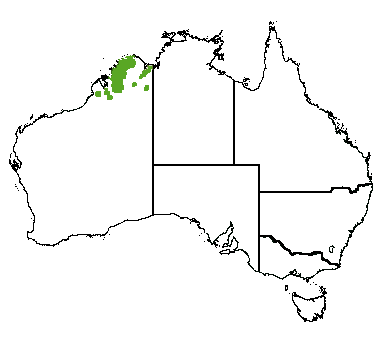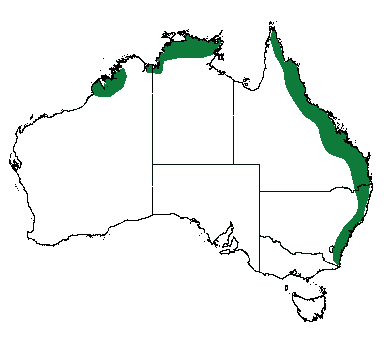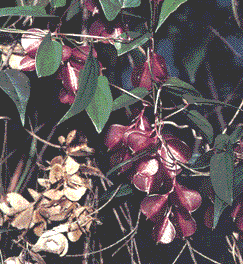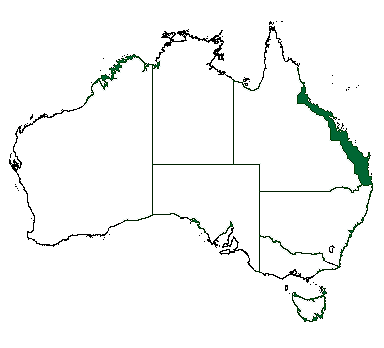|
|
|
Calyx and Rhizome |
|
Alpinea caerulea |
|
Native ginger |
|
|
Family: |
Zingiberaceae |
General notes:The rhizome of the native ginger has a more delicate, floral taste than exotic ginger . (Zingibar officinale). The leaves are also used as decoration or to wrap such foods as fish. A very hardy plant which will grow in shady, damp difficult spotsEdible portion:Underground stem (rhizome) most particularly the tips. Seeds have a thin but pleasantly acid pulpHarvest period:Rhizome year round but favoured 'tips' mainly Nov-Apr. Fruit mainly Dec-MarYrs to maturity:1-2 for roots, 3-4 for fruitForm:ShrubNatural Distribution/Growing conditions:Rainforest margins, coastal area northern Queensland to mid NSW.Climatic/microclimatic conditions:Tropical-subtropical.Management reference:Ginger. Hardy. Prefers semi or full shade.Traditional Aboriginal Use:Pulp around seeds eaten.Density:Not suitable for plantation growingYield at maturity:UnknownHarvesting:As per exotic gingerSupplied as:Whole leaf, fresh rhizome, dried, sugaredTypical value adding:Sugared, dried, candied, pickled. The roots themselves can be dug up and eaten after boiling but the favoured portion is the young tips of the underground stem which emerge. These may be red or green and can be eaten raw or treated as ginger.Current purchasing price:$ UnknownPerceived demand:Low |
|
Adansonia gregorii |
|
Boab |
|
|
Family |
Bombacaceae |
General NotesEdible portionRoots, leaf and fruit (small to large woody capsules that are brownish with a fine hair layer and contain many kidney-shaped seeds embedded in white pith like substance.) Harvest periodFruit set from January to April. Roots harvested - ?. Leaves can be harvested year round. Years to maturity
FormDeciduous tree, 5–15 m high, trunk bottle-shaped. Fl. white, cream. The boab is a large spreading tree up to 15m high with branches that radiate from the top of the swollen barrel like trunk that can be up to 20 metres in circumference The tree has very smooth grey-brown bark and compound leaves that comprise of 5-9 leaflets that are elongated with a pointed tip. Natural Distribution/Growing conditions:Restricted to Northern WA, specifically the Kimberley region. Sandy & loamy soils. Climatic/microclimatic conditions:? Management referenceNil Traditional aboriginal useLocal aboriginal people use Boab nuts as decorative ornaments by scratching pictorial scenes into the nut's surface. Traditionally aboriginal people have used various parts of the tree for food, medicine, water supply, fibre, glue and shelter. Density? Yield at maturity? Harvesting? Supplied as? Typical value adding? Current purchasing price
Perceived demand
|
|
Dioscorea spp, Vigna spp, Abelmoschus spp |
|
Native jam, long yam, native onion, bush potato etc |
D. transversa |
|
Family: |
Dioscoreaceae |
General NotesThere are a wide range of native yams - some very thin and woody, others thick and highly edible. Many of these formed a substantial part of the Aboriginal diet but would not be considered large enough for commercial production. Exception to this might be: Dioscorea transversa and D. bulbifera - Long yam and round yam. A creeper found in the undergrowth of thickets and rainforest. Tubers are cooked like potato. Vigna lanceolata - Bush potato. Thin taproot to 20cm, can be eaten raw or cooked. Favours damp spots, especially along water courses. Abelmoschus moschatus - Bush carrot. A long, thin tuber with a carroty taste.Edible portion:Rhizomes Harvest period:Varies Yrs to maturity:1-3 Form:Usually a ground cover or climber Natural distribution/Growing conditions:examples of species found in all regions. Climatic/microclimatic conditions:examples of species found in all climatic regions. Management reference:as for other tubers. Traditional Aboriginal use:tubers often processed extensively before eating. Many also used medicinally. Density:as for sweet potato Yield at maturity:Unknown Harvesting:Hand or mechanical Supplied as:Fresh Current purchasing price:NCV Perceived demand:Unknown - however reputed medicinal value of many of these plants may increase interest. Research also -Platysace maxwellii - Round yam and P. cirrosa - Kahno. Vigna vexillata - Stringy yam |
|
Hibiscus heterophyllus andH. sabdariffa (not strictly native!) |
|
Native Rosella. Wild Rosella |
|
|
Family: |
Malvaceae |
General notes:Confusion exists regarding the 'wild' and the 'native' rosella. The 'wild' rosella (H. sabdariffa) is, in fact, and import but has been here for so long it's close to being naturalised. The true native rosella is H. heterophyllus. Most of the literature concerns H. sabdariffa but the following relates to both. The plant has scarlet coloured petals (yellow or white for H. heterophyllus) and imparts a crisp, berry-rhubarb flavour. The buds of wild rosella have a crispy berry and rhubarb like taste.See also here | here for WA | here for seeds |and here for an article by the wonderful Colleen Keena Edible portion:Calyx, flowerHarvest period:Year round in good conditions, main flowering period Summer to Autumn. Rockhampton grower notes he is still harvesting in July.Yrs to maturity:1-2Form:Shrub, 3-6m.Natural Distribution/Growing conditions:Coastal and drier rainforest and open forest, SE NSW to NE QLDClimatic/microclimatic conditions:Management reference:Hibiscus. Prefers sun to semi shade conditions and adequate moisture for establishment. May be frost sensitive when young.Traditional Aboriginal Use:UnknownDensity:3mx3m (625/ha)Yield at maturity:Harvesting:Hand removal of calyxes is challenging.Supplied as:Fresh, frozenTypical value adding:Seed must be removed to ship Jams, jellies, sauces, garnish. They are famous for the jam and chutney they flavour so well and lend themselves to pie fillings and other pastries, ice-cream, sorbets and fruit stews. Rosella in a coulis with lemon myrtle oil is an excellent flavour combination.Current purchasing price:$5-$10/kgPerceived demand:High Linkshttp://www.hibiscus.org/culinary.php Green Harvest (seeds) http://www.greenharvest.com.au/seeds/vegetables_r.html Colleen Keena: |
|
|
[resources/includes/footer.htm]
|
|
